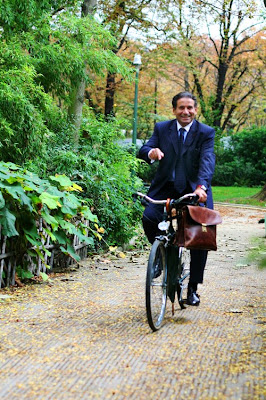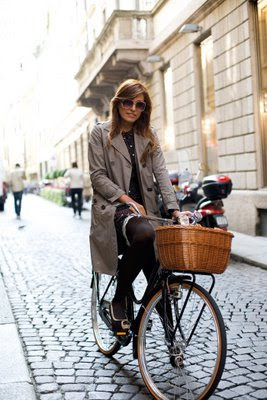I thoroughly enjoyed this post on Copenhagenize.com. It's essentially a two-article exchange between author Mikael and a reader about promoting cycling by making it most convient vs. making it sexy and high status.

(For the record, I'm not calling Ellen Page sexy. This is just good Canadian content.) from copenhagencyclechic.com
Here is an excerpt from the reader's 'article':
Last week Mikael wrote [about] U.S. cycle advocates... who [incorrectly] seem to assume that people will take up bicycles as transportation because it’s the right and moral thing to do.
The infrastructure of Copenhagen is efficient and practical... Really, though, Copenhagenize.com is not selling asphalt and blue paint; it’s selling style.
For people in “developing bicycle cultures,” Mikael offers an alluring ideal, which often involves attractive women (and men) in tasteful clothes, undoubtedly on their way from fabulous apartments to up-to-the-minute offices or chic restaurants and bars, all of which we can imagine filled with well-designed Danish furniture. For a lot of people, this will look like the good life, or at least one version of the good life.

But here’s the problem: for a lot of people in my “developing cycling culture,” the Copenhagenize fantasy does not look like the good life. In San Francisco, New York, Portland, and a few other cities, sure, people are likely to agree. In those few places, Americans really aren’t too different from their urban European counterparts. They want the same things, more or less, and follow the same styles (again, more or less).
But the vast majority of Americans don’t find that lifestyle or its signifiers appealing. It’s not just true that most Americans live in automobile-dependent suburbs; they /like/ living in automobile-dependent suburbs. Even when cycling clearly is the fastest, most convenient way to get somewhere, they won’t do it, and they’ll look with disdain on anyone who does.

In any culture – as far as marketing is concerned – what matters is status. People will buy things if they think they’ll get approval and envy from the people around them. In mainstream U.S. culture, driving a car in a city that has been designed only for driving cars is a high-status activity. It implies that you have a lot of private property (power, wealth, respect) and that you don’t have to enter into public, shared spaces (vulnerability, poverty, disrespect).
In the worldview through which most Americans understand their lives, a car is an extension of the suburban home: independent, private, isolated. And in that worldview, isolation is a good thing. In this world, apartments are bad. Urban life as Mikael presents it is bad. Interactions with strangers are bad. We need protection from strangers, and a mobile steel-and-glass box – the bigger, the better – is the best way to get that protection.
Transportation biking, then, is a low-status activity – a /very/ low-status activity.
What, then, is to be done? I do think it’s possible to market cycling to the mainstream here in the U.S., and in developing cycling cultures around the world. But the way to make that happen is to tie cycling to high-status lifestyles in specific local cultures.Here is the entire article and Mikael's response.
I live in North Carolina... pretty deep in the conservative “red-state” area. Here in Greenville, the current model of the good life includes a big suburban-style house, a really big SUV, a significant dose of evangelical Christianity and a lot of college football. This may not appeal to readers from other parts of the world, but that’s the point: local culture does matter.
But even here, and in much of the South, I can see possibilities. For instance, I think a "Charleston" approach would appeal to quite a lot of people -- blonde sorority girls on updated beach cruisers, tailgate parties with kegs and dogs (arriving by bike trailer), couples who look like George W. and Laura Bush (or even better, Cindy McCain) pulling up on expensive city bikes to big ol' Victorian houses in dense, Spanish-moss-draped neighborhoods right out of Southern Living.
Wherever you live, though, the point is to determine who the high-status people are. They're the ones you need to reach, and they’re the ones you need to co-opt. Others will aspire to follow them. Once cycling becomes a high-status activity, people will do it even where the actual road infrastructure isn’t very friendly – just as they now refuse to do it, even where the roads are pretty good. Like every culture, bicycle culture is all in your head.

No comments:
Post a Comment
Two things:
1) A lot of discussion about this site happens on facebook; so, I would recommend finding the site (link on the right sidebar) and me there.
2) I'm experimenting with non-sign-in commenting to encourage more discussion (the 2 minutes it takes to create a google/other account seems like too much trouble).
Being 'anonymous' is pretty lame, so at least make up a fake name to use.